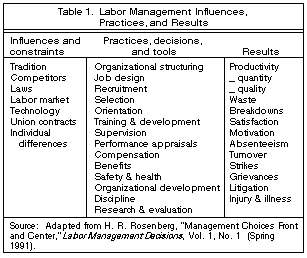

Volume 8, Number 1, Winter-Spring 1999
The connection between risk and labor law violations is direct and obvious. Sometimes not as apparent, but just as vital, is the association between risk and violation of good management principles. Whatever control over production you have at your farm, it is mostly achieved through people. How these people are selected and managed affects your bottom line.
People Mistakes Can Be Costly
Sometimes the effects of poor training and supervision are palpable. For example, under the direction of an inexperienced supervisor, workers planted the cuttings in a vineyard upside down. The ranch manager discovered the error the following spring, when the vines failed to bud out. Because of the supervisor's error, the ranch lost not only the vine cuttings but also a year of valuable vineyard development.
In another case, a new worker on a kiwifruit plantation applied a highly concentrated fertilizer formulation too close to the plants and burned the foliage. Many plants died. The quality of the fruit that did grow was too poor to be marketable through normal channels.
Yet another worker mistakenly milked a penicillin-treated cow into the main tank. The good milk in the bulk tank was contaminated, and all of it had to be discarded.
Other problems are more subtle. "When I first worked here, I really exerted myself. But now I try to do as little as I can and still keep my job." Another put it this way, "I've learned to give my job the time it deserves, but I no longer give any more of my own time. I've been burned by doing so." A third worker confided, "When I'm mad at the supervisor, I do exactly what I'm asked to do ... even if I know a better way of doing something or have a good reason not to do the job the supervisor's way."
Avoiding Problems
These human blunders could have been prevented by selecting knowledgeable, skilled personnel or by providing better orientation, training, and supervision. Tapping motivation, building effective personal relationships, establishing and carrying out a constructive disciplinary process, and encouraging worker input in decision making are all part of labor management.
There are a number of options for solving people problems. Employers who are comfortable using only a few management tools may be limited in their response to a challenge. Some, for instance, attempt to use training when faced with almost any adversity, such as tardiness, misuse of tools, and conflict on the job, whereas others believe that nearly all difficulties can be solved with pay.
Even the right management tool, such as incentive pay to motivate worker performance, may be used inappropriately. One farmer, after learning of a neighbor's success with an incentive program, switched the pay system. The grower offered crew pickers a full day's pay - and the right to leave as soon as they finished - if they would pick an additional bin for the day. The pickers were delighted. Most were through before 11 a.m. The grower was thrilled with the increased productivity but, after the initial excitement wore off, began to feel it was not such a bargain after all. Trying to even out matters, the farmer asked for yet one more bin per day. The crew workers, who may have originally accepted the extra bin as a fair exchange, now instead organized and voted for union representation. They felt their employer had broken an oral contract.
The better an employer understands labor management, the more likely he or she is to choose the right set of tools - and apply them correctly - to deal with a given challenge. Time and effort spent on improving management competence pay off. A vineyard manager found it time-consuming to develop a careful employee selection process for pruners but has continued to use the new hiring practice every year. The approach enables the manager to identify the pruners who are considerably faster than others.
Table 1, adapted from an overview of human resource management developed by Howard Rosenberg, shows the external constraints on the workplace in the left column. The center column displays the tools and principles of labor management, and the column to the right indicates potential results or outcomes.

I like to think of the practices, decisions and tools in the middle column as potential filters or magnifiers for the result column. When properly carried out, these processes can help increase positive outcomes and reduce potential risks. In the absence of the middle column, external influences may have a pronounced effect on productivity and other sought-after results. For example, without a careful approach to employee selection, a farmer will often hire the first person who shows up and asks about a job. The quality and potential of the employee is then almost entirely a question of luck. If the farmer uses a systematic selection approach instead, candidates are then filtered so that only those who are most capable surface.
The same is true of the rest of the practices, decisions, and tools column. Each item has the potential to contribute something to increasing positive results and reducing negative ones. While we often focus on the challenges brought about by laws, technology, and other factors, we should not lose sight of the steps farm employers can take to reduce risk and improve management results.